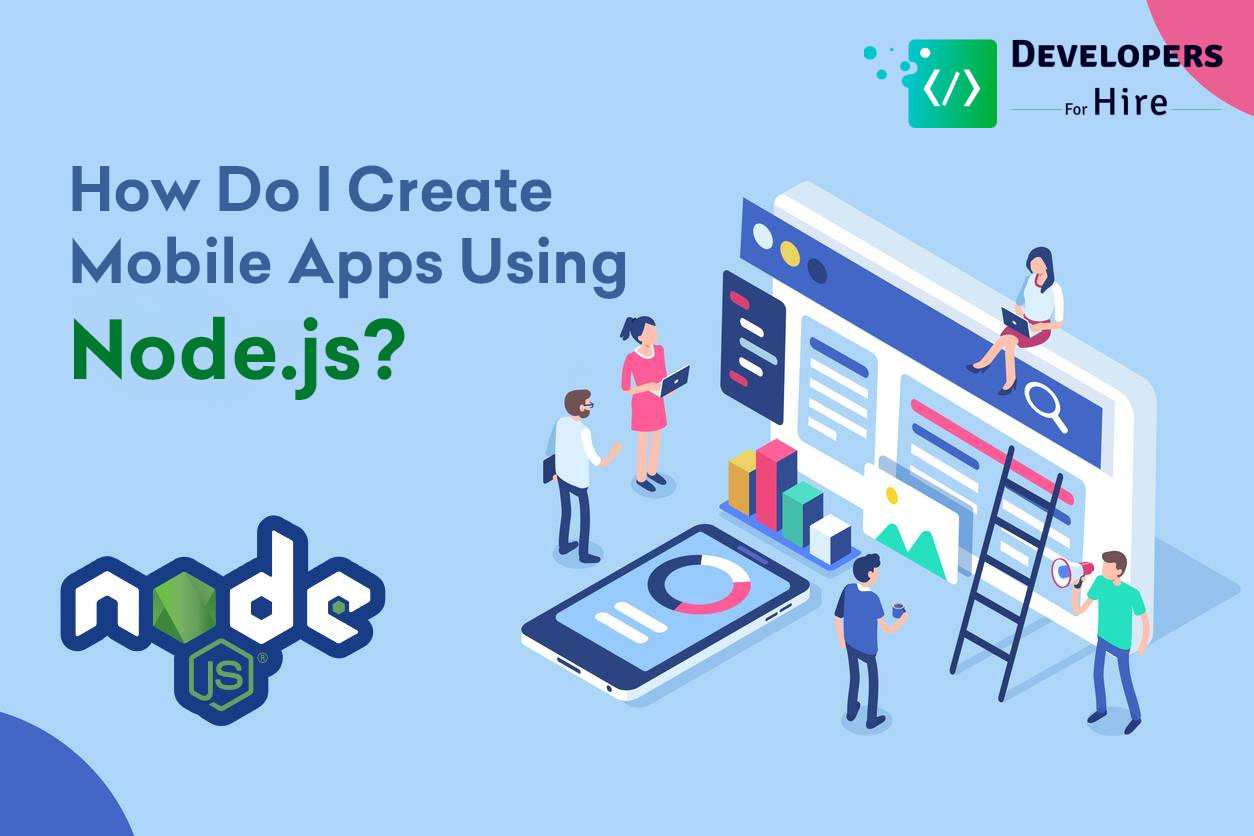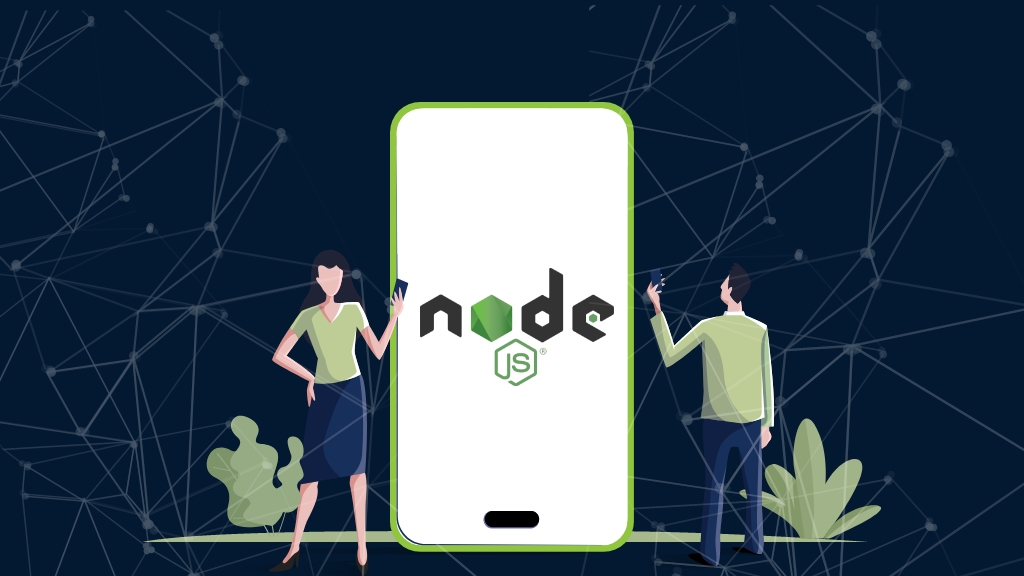Around one and a half decades back (in 2009), when Ryan Dahl (the developer of Node.js) launched the very first version of Node, who would have imagined that it would become the top choice among startups and large-scale enterprises in such a short period of time? Today, most developers are aware of this hype over Node.js development. That’s why queries like How do I create mobile apps using node.js, are making rounds on the internet these days.
While it’s not a beginner’s task to create a mobile app on your own, especially when you lack technical knowledge; however, it is not rocket science for people with a bit of or a good understanding of technological know-how. You can use this tutorial to understand the process of creating a mobile app with Node.js.
By following this tutorial, you can create robust, scalable mobile applications that are secure and easy to maintain. But before we start, let’s first explore the benefits of using Node.js for mobile app development.
Why Should You Choose Node.js for Mobile App Development?

There are numerous benefits that come along when you choose Node.js for your mobile app development. Before moving on to the process of how do I create mobile apps using node.js, let’s take a look at some advantages of this JavaScript runtime.
Single Language for Front-end and Back-end
Node.js uses JavaScript as its main programming language on both the client and server side. It streamlines and speeds up the development process and enables code reuse. With Node.js, you can utilize a single programming language for the front-end and back-end, which eliminates the need for context switching and improving productivity.
Asynchronous Programming
Node.js is built on a non-blocking I/O and event-driven model, which makes it perfect for developers to handle concurrent and multiple operations. This functionality is particularly beneficial for mobile app developers who focus on real-time communication and responsiveness for optimal user experience.
Rich Package Ecosystem
Node.js development comes with a Node Package Manager (NPM), which is a collective collection of open-source modules and libraries. They can simplify the implementation of advanced functionalities in mobile apps. NPM repositories provide well-maintained packages for handling APIs, integrating databases, and adding authentications
Scalability
Node.js’s lightweight and non-blocking architecture allows it to handle numerous simultaneous connections efficiently. This scalability is crucial for high-end mobile apps, as they need to control varying traffic levels and user demand.
Real-time Applications
With Node.js, developers can build real-time apps like gaming platforms, chat apps, and eCommerce apps. It is supported by WebSocket, which enables seamless bi-directional communication and collaboration between the client and the server. This makes Node.js ideal for modern mobile app requirements.
Cross-platform Compatibility
Node.js is an ideal choice for cross-platform mobile app development. Developers can use advanced frameworks such as React Native and NativeScript to reuse code on multiple platforms, including Android and iOS. This significantly reduces development time and cost, making it easier to reach a wider audience.
Community Support
Node.js has a vast and active community of developers who contributes to the ecosystem’s growth. This vibrant community offers valuable resources, plugins, libraries, and updates. It makes it easier for entry-level developers to find solutions to their challenges and stay updated with the latest trends and development in mobile app development.
Server-side Rendering (SSR)
Node.js supports server-side rendering. It is a technique where the server renders a web page and sends the pre-rendered HTML to the client, significantly reducing the time it takes to display the content. SSR improves app performance, especially on slower mobile networks and devices, leading to better user experience and SEO rankings.
Support for Microservices Architecture
Node.js allow developers to break down complex apps into smaller and more manageable components due to its microservices architecture. It helps simplifies app maintenance, increases scalability, and facilitates parallel development of different parts of the app, leading to faster deployment cycles.
Real-time Analytics
Node.js, combined with tools like Socket.IO, enables real-time analytics in mobile apps. This feature is valuable for apps that require instant updates on user activities, allowing businesses to gain insights into user behavior, track performance, and make data-driven decisions.
High Market Adoption
As of September 2021, Node.js had over 56% market share among developers for building server-side applications, according to the Stack Overflow Developer Survey. This high market adoption adds to the popularity of this JavaScript runtime environment.
High Performance
The world’s largest professional network – LinkedIn, reported a 20x reduction in response times and a 2x reduction in the number of servers after adopting Node.js for its mobile application.
How to Build a Mobile App Using Node.js?
In this section, you will get an accurate answer and a step-by-step tutorial on how do I create mobile apps using Node.js. So, let’s start our step-by-step tutorial to make you understand the process better:
Prerequisites
Before starting to create mobile apps using Node.js, ensure you have the following installed:
- Node.js and npm
- Expo CLI (Expo is a framework for React Native)
- A code editor of your choice (e.g., Visual Studio Code)
Step 1: Setting Up the Project
- Install Node.js and NPM on your computer or laptop.
- Install Expo CLI globally using npm syntax: “npm install -g expo-cli”
- Create a new project directory using the syntax “expo init YourAppName”
- Choose a template (e.g., “blank”) and wait for the project to be initialized.
Step 2: Designing the App UI
- Navigate to the project directory in your code editor.
- Open the “App.js” file and start designing your app’s user interface using React Native components.
Step 3: Implementing Functionality
- Create separate components for different app screens (e.g., HomeScreen, ProfileScreen).
- Add navigation using React Navigation to switch between screens.
- Implement functionalities such as handling user input, displaying data, and making API calls.
Step 4: Setting Up the Node.js Back-end
- Create a new directory for the back-end of your project.
- Initialize a new Node.js project inside the back-end directory using the syntax “npm init”
- Install necessary dependencies like Express, MongoDB (if using), and any additional libraries for your app’s specific needs.
Step 5: Building & Integrating APIs
- Define routes and handlers for the APIs you want to expose from your Node.js back-end.
- Use libraries like Express to create a server and handle requests and responses.
Step 6: Integrating Front-end with Back-end
- Update your Node.js app to make API calls to the back-end using libraries like Axios or Fetch API.
- Ensure data exchange between the front-end and back-end is seamless.
Step 7: Testing and Debugging
- Test your app on real devices or simulators/ emulators.
- Use debugging tools like Expo Developer Tools or React Native Debugger to identify and fix issues.
Step 8: Preparing for Deployment
- Optimize your app’s code for production.
- Prepare necessary assets like icons and splash screens.
- Follow platform-specific guidelines for publishing to app stores.
Average Cost Estimation for Creating Mobile Apps using Node.js
Now that you have got an answer to the much-awaited question – How Do I Create Mobile Apps Using Node.js? It is time to move forward and understand the cost associated with the development.
The actual cost of developing a high-end mobile app using Node.js can vary widely based on the project’s complexity and scope. On average, a simple mobile app with basic features can cost around $10,000 to $30,000. A mid-level app with moderate complexity and additional functionalities may range from $30,000 to $100,000.
For more complex and feature-rich apps, especially those requiring real-time communication, real-time analytics, and extensive database integration, the cost can exceed $100,000 and go up to several hundred thousand dollars.
Factors that Influence the Cost of Developing Mobile Apps Using Node.js?
While Node.js offers several advantages for building cost-effective mobile applications, there are various aspects that can impact the overall development cost:
Developer Costs
The cost of hiring skilled Node.js developers can vary based on their expertise, location, experience, and the app’s complexity. Hiring developers from regions with lower labor costs might reduce expenses, but it’s essential to ensure the quality and expertise of the team.
Infrastructure and Hosting
Node.js applications can be hosted on cloud platforms like AWS, Azure, or Heroku, which offer a flexible pay-as-you-go pricing model. The cost will depend on factors such as server requirements, data storage, and bandwidth consumption.
Third-Party Services and APIs
Integrating third-party services and APIs can enhance your app’s functionality, but some may come with usage-based pricing or subscription fees. It’s crucial to assess the long-term cost implications before integrating such services.
Testing and Quality Assurance
Investing in comprehensive testing and quality assurance is essential to deliver a stable and bug-free app. The cost will depend on the extent of testing required and whether you hire a dedicated testing team or use third-party services.
Conclusion
With the tutorial above, we hope you find the best answer on how do I create mobile apps using Node.js. By following the step-by-step instructions and leveraging the power of Node.js, you have learned to build versatile, efficient, and scalable mobile applications.
Node.js’s ability to use JavaScript on both the server and client sides enables seamless communication and synchronization between various components, enhancing the overall user experience.
Throughout this tutorial, we’ve explored various tools, libraries, and frameworks that can expedite development and make your app stand out in the competitive mobile landscape.


